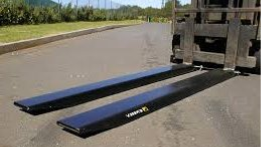Maximize Your Load: A Guide to Forklift Extensions for Enhanced Efficiency
Maximize Your Load: A Guide to Forklift Extensions for Enhanced Efficiency
Blog Article

In today's fast-paced industrial environment, maximizing efficiency is more important than ever. Forklifts play a crucial role in material handling, and with the right equipment, they can significantly enhance productivity. One often-overlooked tool that can elevate your forklift's capabilities is fork lift extensions. These extensions not only expand the reach and versatility of your forklift but also enable you to handle larger and heavier loads with ease.
Understanding the various types of fork lift extensions available and how to select the right one for your needs can make a substantial difference in your operations. By optimizing your forklift’s load capacity, you can streamline processes, reduce the number of trips required, and ultimately save time and resources. In this guide, we will explore the benefits of fork lift extensions and provide insights on how to use them effectively to maximize your load handling capabilities.
Types of Forklift Extensions
Forklift extensions come in various types, each designed to cater to specific lifting needs and enhance the overall efficiency of material handling. One common type is the standard fork extension, which easily attaches to the existing forks of the forklift. These extensions provide increased length, allowing operators to lift wider loads securely. They are often used in warehouses and distribution centers where pallets or large items need to be moved efficiently.
Another popular type is the heavy-duty fork extension, which is built to handle more substantial weights and larger dimensions. These extensions often feature reinforced construction and are designed for more demanding industrial applications. They help lift bulky items such as steel coils or large timber pieces, making them essential for construction sites and manufacturing facilities.
Lastly, there are specialized fork extensions, such as those tailored for specific products or environments. For instance, some extensions are designed for handling rolls of fabric, while others might cater to appliances or cylindrical materials. These specialized options ensure that the correct handling equipment is available to maximize safety and efficiency in diverse operational contexts.
Benefits of Using Extensions
Using forklift extensions significantly increases the versatility of your lifting equipment. By allowing operators to handle longer and wider loads, these extensions enable businesses to optimize their material handling processes. With the ability to move larger items efficiently, companies can enhance productivity while minimizing the number of trips needed to transport goods.
Another key benefit is improved stability during lifting operations. Extensions are designed to distribute the weight of the load more evenly across the forks. This added stability minimizes the risk of tipping or dropping heavy items, promoting safer working conditions for operators and other personnel involved in the handling process. Increased safety not only protects employees but also reduces potential costs associated with accidents and equipment damage.
Finally, incorporating forklift extensions into your operations can lead to better inventory management. With the capability to handle various sizes of loads, businesses can maximize their storage efficiency and streamline their logistics. This flexibility allows for quicker retrieval of goods, reducing downtime and enhancing overall operational efficiency, which ultimately drives profitability.
Choosing the Right Extension
When selecting the right forklift extension, it is essential to consider the specific tasks you will be performing. Different operations may require different types and lengths of extensions, so understanding your needs will help in making an informed decision. Assess the types of loads you frequently handle, as this will dictate the length and strength required from the extension. Choosing an extension that matches your operational requirements ensures optimal efficiency and safety.
Fork Lift Extensions
Another critical factor is compatibility with your forklift model. Not every extension will fit every forklift, so it's crucial to check the specifications provided by both the extension and forklift manufacturers. Ensuring that the extension is designed to work seamlessly with your equipment will reduce the risk of accidents and enhance the overall performance of the forklift. Always refer to the guidelines provided for your forklift to confirm compatibility before making a purchase.
Safety should always be a priority when selecting forklift extensions. Opt for extensions that come with safety features such as reinforced construction and locking mechanisms. Extensions that are not designed with safety in mind can lead to disastrous results, including accidents and injuries. By investing in high-quality extensions that prioritize safety, you not only protect your workers but also increase the longevity of your equipment through proper use.
Safety Considerations
When utilizing fork lift extensions, it is crucial to prioritize safety to prevent accidents and injuries. Operators should always be trained in the correct use of extensions, as improper handling can lead to tipping hazards or loss of load control. It's essential to adhere to the manufacturer’s guidelines regarding load capacity and to ensure that the extensions are compatible with the specific forklift. Regular safety checks should be conducted to verify that the extensions are securely attached and in good condition before each use.
Load stability is another key aspect to consider when using extensions. The longer the fork lift extensions, the more susceptible the vehicle becomes to balance issues. Operators should be aware of the center of gravity of the load and ensure that it is within the safe operating range of the forklift. It is advisable to carry loads as low to the ground as possible, reducing the risk of toppling. Clear communication among the team is vital when maneuvering heavy or bulky items, ensuring everyone is aware of the operation and potential risks.
Lastly, wearing appropriate personal protective equipment is essential for anyone working in proximity to fork lift operations. This includes helmets, safety shoes, and high-visibility vests. Moreover, establishing a designated area for loading and unloading can create a safer environment. By emphasizing these safety considerations, forklift operators can enhance efficiency while minimizing risks associated with the use of fork lift extensions.
Report this page